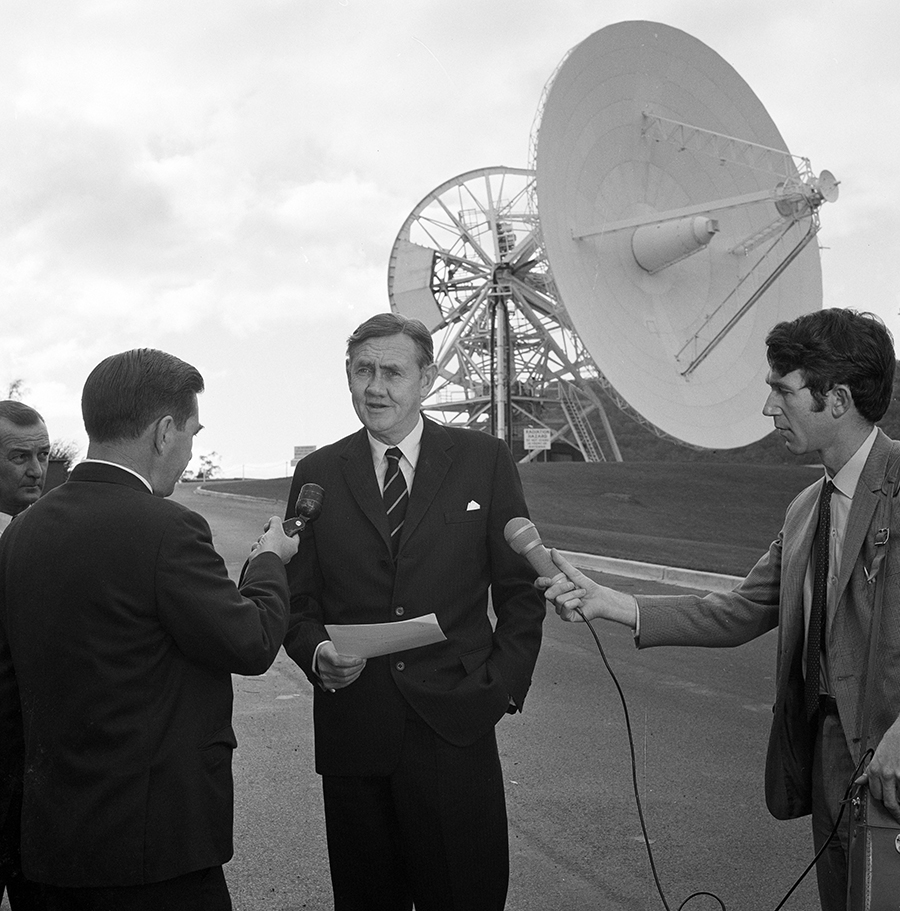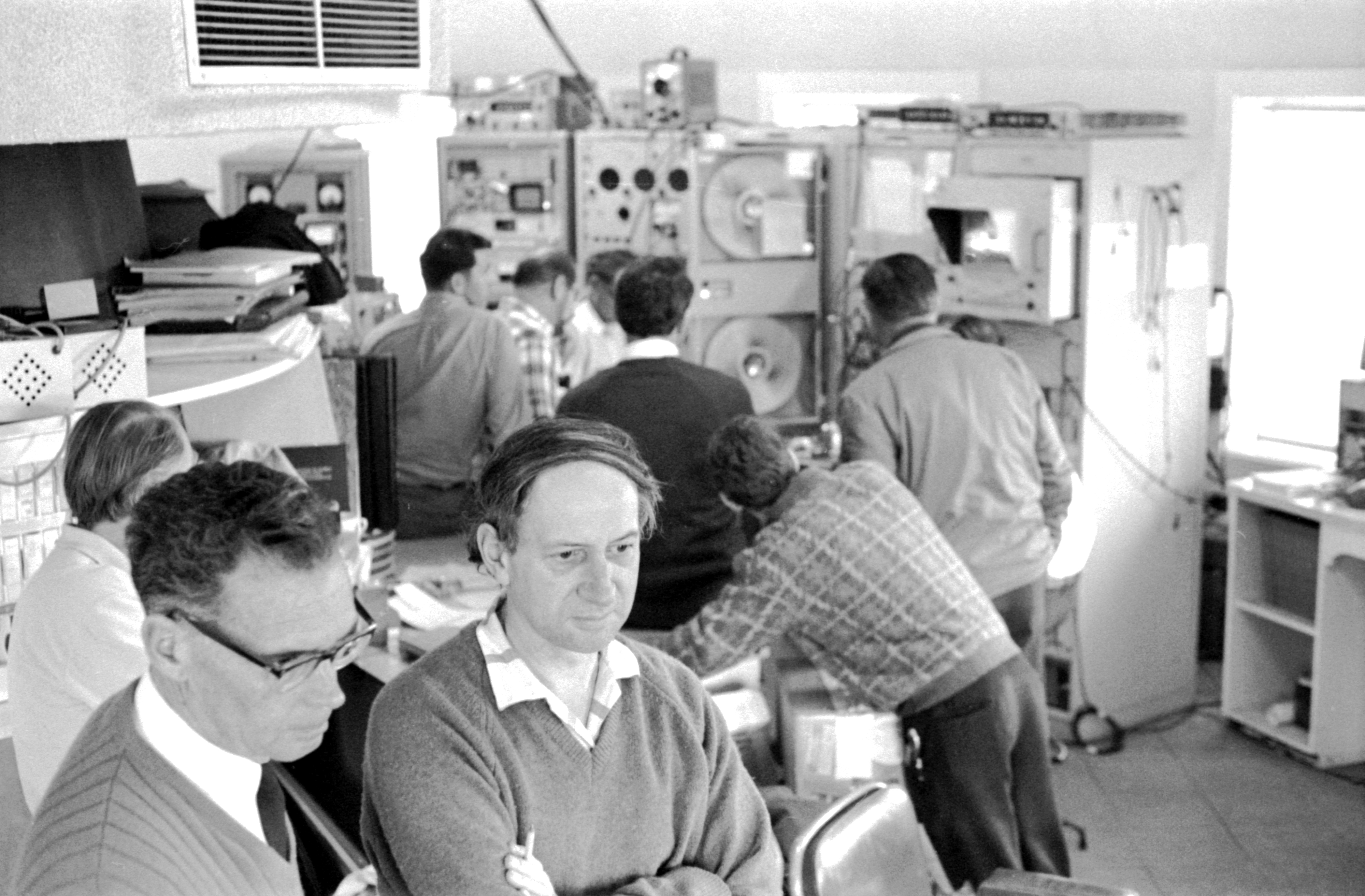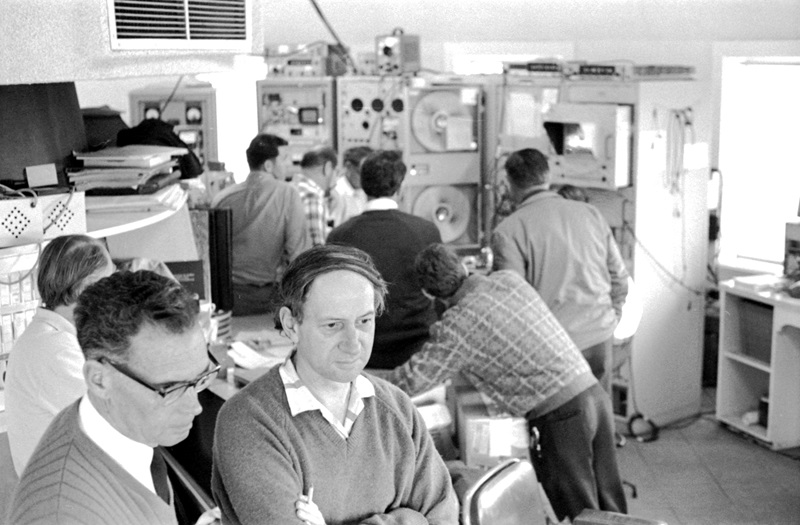 At 12.56 pm on 21 July 1969 Australian Eastern Standard Time (AEST), mankind took its 'one giant leap' and 600 million people watched as Neil Armstrong walked on the Moon.
At 12.56 pm on 21 July 1969 Australian Eastern Standard Time (AEST), mankind took its 'one giant leap' and 600 million people watched as Neil Armstrong walked on the Moon.
Murriyang, our Parkes radio telescope, famously supported receiving the television signals on that momentous day. Although many people think the Parkes telescope was the only station receiving the signal, it was the 26-metre antenna at NASA's Honeysuckle Creek space tracking station near Canberra that was the prime station assigned with receiving the initial TV pictures from the Moon and Neil Armstrong's first steps on the lunar surface. (The Tidbinbillla deep space tracking station, today known as the Canberra Deep Space Communication Complex, provided support to the command module in lunar orbit.)
Eight and a half minutes after those first historic images were broadcast around the world, the television signal being received by the larger 64-metre Parkes telescope was then selected by NASA to provide the images for the following two hours and 12 minutes of live broadcast as the Apollo 11 astronauts explored the Moon surface.
While the telescope successfully received the signals, the occasion didn't go without a hitch. The lunar module had landed at 6.17am AEST. Astronauts Neil Armstrong and Buzz Aldrin were supposed to rest before the Moonwalk, but Neil Armstrong was keen to get going. The astronauts were slow getting into their suits and when they got outside the Moon was rising over Parkes.
 The telescope was fully tipped over, waiting for the Moon to rise, when a series of strong wind gusts – 110 km per hour – hit. They made the control room shudder and slammed the telescope back against its zenith axis gears. Fortunately, the wind slowed, and Buzz Aldrin activated the TV camera just as the Moon came into the telescope's field-of-view.
The telescope was fully tipped over, waiting for the Moon to rise, when a series of strong wind gusts – 110 km per hour – hit. They made the control room shudder and slammed the telescope back against its zenith axis gears. Fortunately, the wind slowed, and Buzz Aldrin activated the TV camera just as the Moon came into the telescope's field-of-view.
At this time, Honeysuckle Creek was taking the main signal. Eight minutes later the Moon was in the Parkes main detector's field-of-view and NASA switched to Parkes. The weather was still bad, and the telescope operated well beyond its safety limits.
The signals received by Parkes were sent to Sydney. From there the TV signal was split. One signal went to the Australian Broadcasting Commission, the other to Houston for the international telecast.
The international signal had to travel halfway around the world from Sydney to Houston, adding a delay. So Australian audiences saw Neil Armstrong's historic first step 0.3 seconds before the rest of the world.
The Australian film about Murriyang, our Parkes radio telescope, called 'The Dish', is great entertainment, but not entirely historically accurate. In fact, many CSIRO staff were involved, at Parkes and elsewhere.
Parkes staffer Neil 'Fox' Mason was at the control desk, guiding the telescope. Despite being at the centre of the action, he couldn't turn around to watch the incoming pictures. Instead, he had to monitor the telescope's tracking, in case the wind picked up again. And nobody has ever played cricket on the Dish.

At 12.56 pm on 21 July 1969 Australian Eastern Standard Time (AEST), mankind took its 'one giant leap' and 600 million people watched as Neil Armstrong walked on the Moon.
Murriyang, our Parkes radio telescope, famously supported receiving the television signals on that momentous day. Although many people think the Parkes telescope was the only station receiving the signal, it was the 26-metre antenna at NASA's Honeysuckle Creek space tracking station near Canberra that was the prime station assigned with receiving the initial TV pictures from the Moon and Neil Armstrong's first steps on the lunar surface. (The Tidbinbillla deep space tracking station, today known as the Canberra Deep Space Communication Complex, provided support to the command module in lunar orbit.)
Eight and a half minutes after those first historic images were broadcast around the world, the television signal being received by the larger 64-metre Parkes telescope was then selected by NASA to provide the images for the following two hours and 12 minutes of live broadcast as the Apollo 11 astronauts explored the Moon surface.
While the telescope successfully received the signals, the occasion didn't go without a hitch. The lunar module had landed at 6.17am AEST. Astronauts Neil Armstrong and Buzz Aldrin were supposed to rest before the Moonwalk, but Neil Armstrong was keen to get going. The astronauts were slow getting into their suits and when they got outside the Moon was rising over Parkes.
The telescope was fully tipped over, waiting for the Moon to rise, when a series of strong wind gusts – 110 km per hour – hit. They made the control room shudder and slammed the telescope back against its zenith axis gears. Fortunately, the wind slowed, and Buzz Aldrin activated the TV camera just as the Moon came into the telescope's field-of-view.
At this time, Honeysuckle Creek was taking the main signal. Eight minutes later the Moon was in the Parkes main detector's field-of-view and NASA switched to Parkes. The weather was still bad, and the telescope operated well beyond its safety limits.
The signals received by Parkes were sent to Sydney. From there the TV signal was split. One signal went to the Australian Broadcasting Commission, the other to Houston for the international telecast.
The international signal had to travel halfway around the world from Sydney to Houston, adding a delay. So Australian audiences saw Neil Armstrong's historic first step 0.3 seconds before the rest of the world.
The Australian film about Murriyang, our Parkes radio telescope, called 'The Dish', is great entertainment, but not entirely historically accurate. In fact, many CSIRO staff were involved, at Parkes and elsewhere.
Parkes staffer Neil 'Fox' Mason was at the control desk, guiding the telescope. Despite being at the centre of the action, he couldn't turn around to watch the incoming pictures. Instead, he had to monitor the telescope's tracking, in case the wind picked up again. And nobody has ever played cricket on the Dish.

